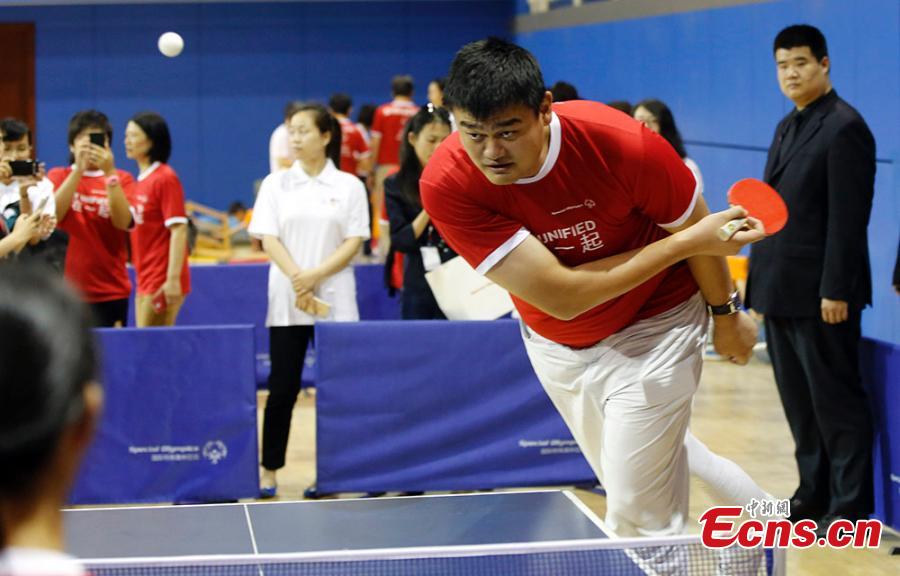(Ecns.cn) -– China launched its first space lab module Tiangong-1, or "Heavenly Palace 1," Thursday evening at the Jiuquan Satellite Launch Center in northwestern China.
President Hu Jintao applauded the successful launch of China's first space lab module Tiangong-1, and shook hands with the staff of the Beijing Aerospace Flight Control Center.
According to Xinhua's report, other members of the Standing Committee of the Political Bureau of the Communist Party of China (CPC) Central Committee, including Wu Bangguo, Jia Qinglin, Li Changchun, Xi Jinping, Li Keqiang and Zhou Yongkang, were also present at the control center.
Premier Wen Jiabao and He Guoqiang, also members of the Standing Committee of the Political Bureau of the CPC Central Committee, shook hands with the staff at the Jiuquan Satellite Launch Center to congratulate on the success.
Tiangong-1, which is scheduled to dock with the Shenzhou-8 spacecraft later this year, will pave the way for building China's first space station.
During its two-year service life, Tiangong-1 will mainly conduct four missions, such as experiments of autonomous rendezvous and docking procedures with the Shenzhou-8, -9, and -10 spacecrafts in forthcoming launches, aiming to establish the country's first space lab, according to Wu Ping, spokesperson for China's national space administration.
Loaded in a more powerful carrier rocket
The Long March-2FT1 is the latest model of the Long March-2 rocket series, which features 170 modifications after the recent failure of the Long March-2C in a satellite launching mission last month. In order to facilitate improved fuel volume and ensure a more powerful thrust force, engineers have sorted out problems that might occur after blast off and equipped it with modified boosters.
The current 2FT1 measures 52 meters in length, and is capable of carrying an 8.6 ton payload into low Earth orbit. With the 8.5-ton Tiangong-1 module loaded, the carrier rocket will soar to a near circular orbit at the height of about 350 kilometers above horizon.
In the first 100 seconds after launch, one can clearly see the flight path of the rocket with naked eyes. Experts will need some 40 minutes to judge whether Tiangong-1 is functioning properly, because it will be on the dark side of the Earth about ten minutes after launch and ground control needs about half an hour to gauge it.
Zhu Jin, curator of the Beijing Planetarium, revealed that when Tiangong-1 enters into a fixed orbit one or two days after launch, citizens in Beijing can also observe it with the naked eye. The shape of it will be like a shining star. The Beijing Planetarium will release its position data to the public at that time.
Four main missions
Bai Mingsheng, deputy designer-in-chief at the space lab system of the Chinese Academy of Space Technology, told China News Service that Tiangong-1 space lab is assigned four major tasks: space rendezvous and docking with the Shenzhou spacecrafts; control and management over the combining body of the two crafts, including orbit control and cabin atmospheric monitoring; experiments on space technology, space medical science, and regenerative life support; and technological verification of the experimental space station.
Qi Faren, academician of the Chinese Academy of Sciences, who was the first designer-in-chief of the Shenzhou spacecraft series, pointed out that during the space laboratory phase, which is the second phase of China's three-step manned space projects, the main task is to develop critical technologies in setting up a space station.
The duty is highly demanding in four aspects: (1) astronauts walk out of the cabin, which has already been achieved by the Shenzhou-7; (2) two aircrafts achieve rendezvous and docking, which is expected in the near future, between Tiangong-1 and Shenzhou-8, -9, and -10 spacecrafts, respectively; (3) flying spacecraft can be supplemented with resources from the ground; and (4) the space station is assured of air and water cyclic utilization by a regenerative life support system. The last two are still in process of being researched.
Hard techniques to master
Rendezvous and docking are hard techniques to master, as the mission requires two craft to travel at speeds of 28,000 km/h to enter the same orbit and connect with precision.
According to Zhang Jianqi, former deputy director of the China Manned Space Engineering Office and vice commander of the Shenzhou-7 spacecraft program, China has already achieved the first goal of its three-step plan of constructing a space station by 2020, which is sending astronauts to outer space.
Zhang noted, by launching Tiangong-1, China aims to make various experiments and obtain breakthroughs in manned space flight technologies. Among them, the rendezvous and docking experiments are the most difficult ones.
For example, China planned to launch the Shenzhou-8 aircraft in the upcoming November. To ensure the success of space rendezvous and docking between Tiangong-1 and Shenzhen-8, the relative speed of these two craft must be limited within 0.2 meters per second, and the lateral deviation must be confined to less than 18 centimeters.
Safety standards higher than international ones
As a self-developed experimental space station, the safety standards of China's own design is much higher than that of international space stations. This is because it does not have complicated functions and, thus, is less likely to run into problems.
Pang Zhihao, a researcher from the Chinese Research Institute of Space Technology, revealed that the service life of Tiangong-1 is two years, which is much shorter than international standard of between five to ten years. With a smaller scale and fewer docking ports, it can only use the fuel that it carries from Earth without any replenishment. Besides, it does not need regular maintenance during the two-year service life.
In general, Tiangong-1 is a simple experimental module, which only carries out experiments, basic training, and other less complicated tasks.
Female astronauts may enter Shenzhen-10
Spokesperson Wu Ping also noted that the Shenzhou-10 manned spacecraft is likely to carry Chinese female astronauts into space. He said it is uncertain whether Shenzhou-8 will carry astronauts, but if the rendezvous and docking experiments succeed, in the near future, we may see female astronauts on the aircraft.
According to Wu, China has already selected a group of female astronauts and now some of them are also under training for rendezvous and docking missions. The Shenzhou-10 will carry two female astronauts who are selected from the air force.


















